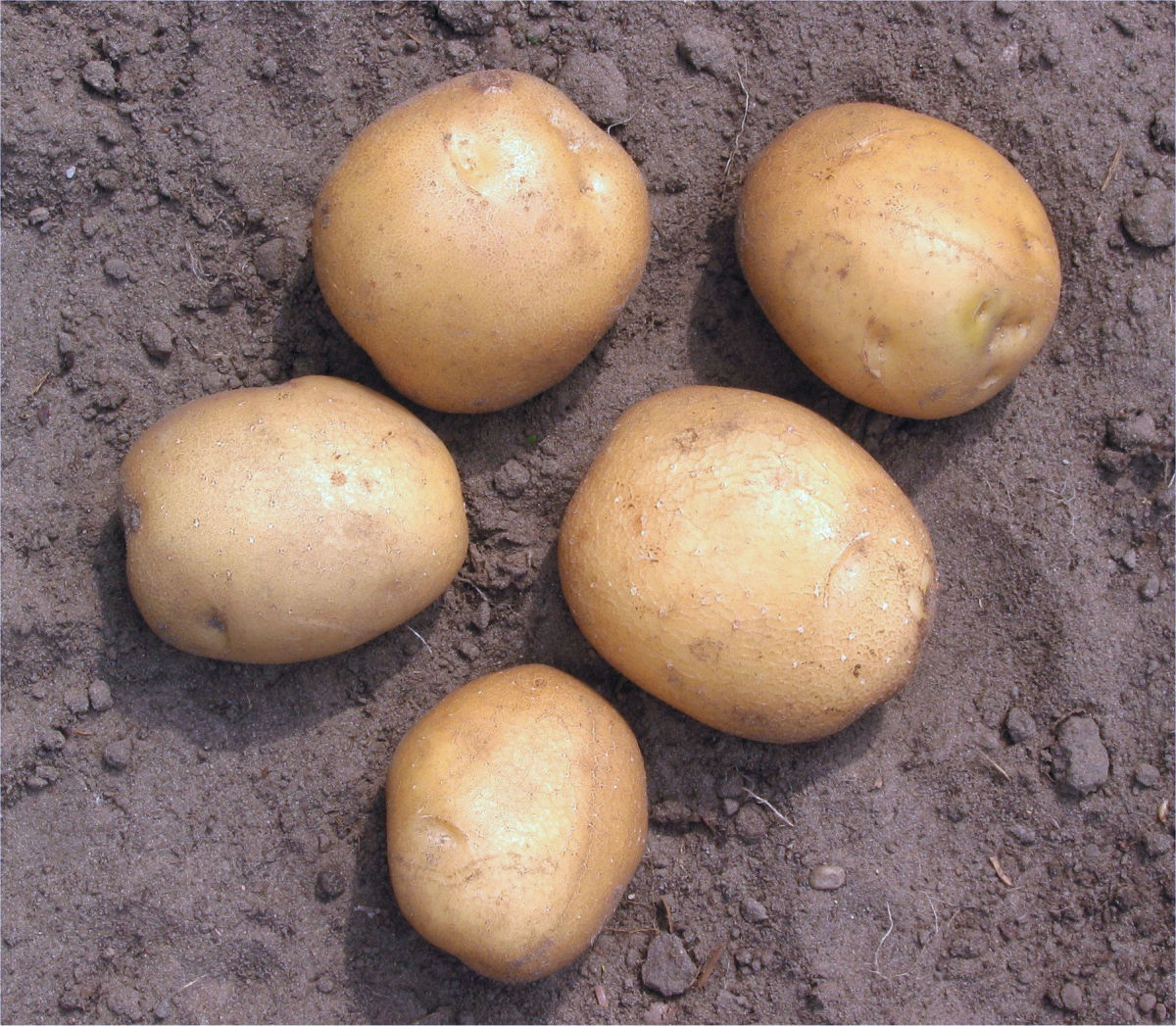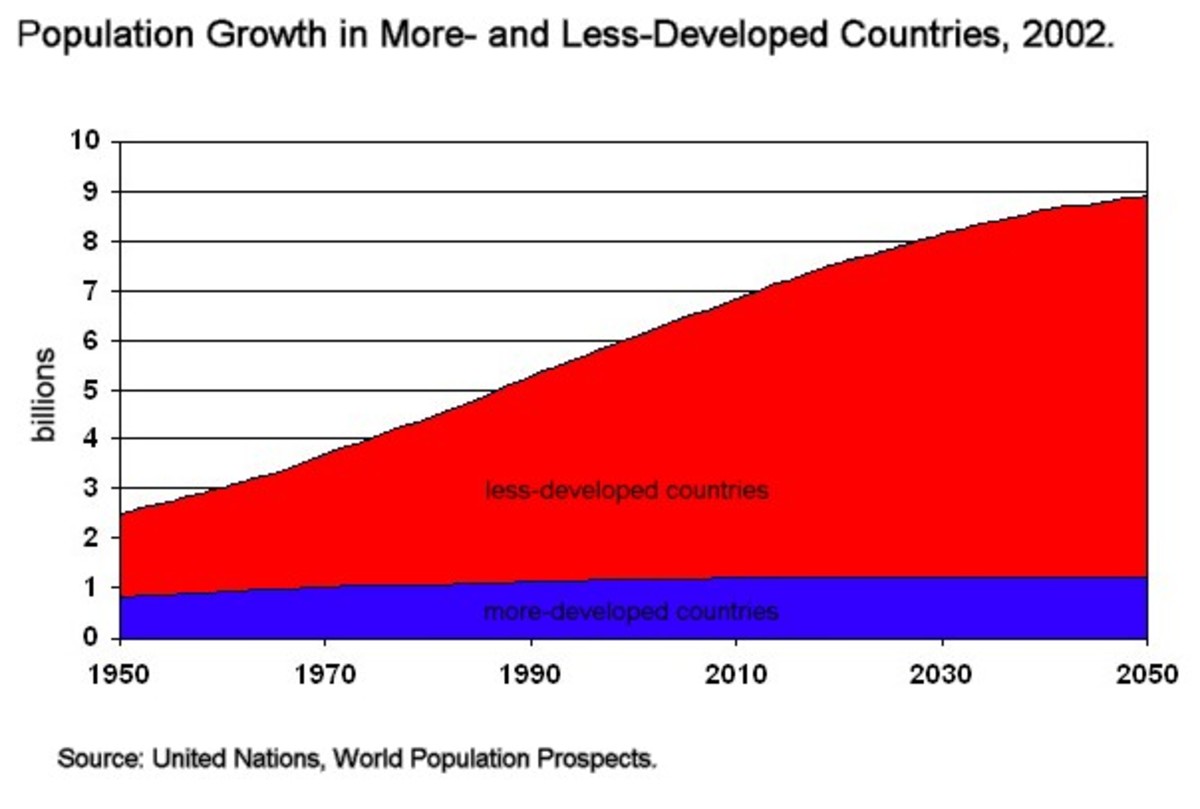The Importance of Ethical and Sustainable Eating & How To Go About It
Modern food production places an emphasis on animal foods and fewer plant foods, packaged and processed foods and foods for exports and imports. This leaves a significant and tangible ecological footprint, including:
- Significant greenhouse gas emissions
- Significant water consumption
- High energy consumption and wastage from the processing, packaging and transportation of food
- Loss of biological diversity due to mass production
- Land degradation due to intensive agricultural practices. In 2008, the International Fund for Agricultural Development estimated that 12 million hectares of productive agricultural land is lost each year to land degradation.
- Wasting energy resources by producing animal and processed foods for someone that has more than enough, while depriving someone else of adequate food and nutrients
- Mistreatment of animals
- Depleting global phosphate reserves (essential to fertiliser)
According to the latest United Nations Report, the world population is currently close to 7 billion and is expected to increase to 9.3 billion by the middle of the century and 10.1 billion by 2100, with the fastest growth occurring in Africa (increasing from the current population of 1 billion to 3.6 billion during this century). The projected population growth threatens to exacerbate global food security as world food demand is estimated to increase by 75% by 2050.
Given the ramifications of modern food production and food choices, many are questioning where food comes from and where it goes and will there be enough to feed the earth's growing population. Hence, the concept of ethical and sustainable eating is becoming increasingly important.
Sustainability and Ecological Footprint of Meat Consumption
Current and future trends in global meat consumption are unsustainable. An emerging middle class in the developing world has resulted in the increasing demand for protein (eggs, milk and meat) and meat consumption has been increasing at over 5% per year over the last few decades amongst developing countries (Food and Agriculture Organisation, 2003). Global meat production is projected to double by 2050. The increasing demand for protein means more livestock and land is required, resulting in increasing scarcity of land.
- Approximately 25% of the global surface area is used for managed grazing land and around 34% of cropland is used to feed livestock. This is inefficient use of land as it could be used to feed the hundreds of millions of starving people rather than feeding animals.
- Livestock accounts for approximately 18% of global warming effects– this is more than the transportation sector.
- Significantly, more energy and resources (water, cropland, fertiliser and pesticides) are needed to obtain nutrients from animals sources compared to plant sources. Energy is expended on housing, transporting and slaughtering animals and transporting and processing feed grains and meat.
Litres of water required to produce 1kg of product: a comparison between some plant and animal foods
Potatoes–500L
Wheat–900L Rice–1,910L
Chickens–3,500L
Beef, broad acre–50,000L
Beef (lot feed, USA)–100,000L
Animal Welfare
The growing demand for meat has led to rearing animals in feedlots. Animals raised in feedlots are housed in conditions with little regard for animal welfare–they live in close proximity to one another, live amongst their own manure, never given the opportunity to roam and graze the land, feed on dirty food and water and are fed growth hormones and antibiotics to speed up the fattening process. Animals are merely a capitalistic commodity - it is all about maximum output at minimal costs.
Reducing the Ecological Footprint from Meat Consumption – Personal Action
- Avoid lot-fed beef as this means of producing meat uses considerably more energy and resources (grain, water) compared to other meat sources. There is also the issue of animal welfare for animals raised in feedlots.
- Decrease red meat consumption
- Favour meats such as chicken or pig as the production of meat from smaller animals leaves a smaller carbon footprint
- Raise chickens at home if appropriate and feasible. They feed on scraps and produce eggs.
- Increase vegetable intake–go vegetarian a few days a week or substitute meats with products such as lentils or mushrooms. A diet high in plant foods is more sustainable as it uses less energy and water, produces less greenhouse gases and uses land more efficiently.
Reducing the Ecological Footprint from Meat Consumption –Potential Legislative & Scientific Intervention
At a policy and legislative level, countries can reduce the export of beef, lamb and dairy products
Science is currently exploring the possibility of manufacturing meat in cell culture through tissue engineering. Potential advantages:
- No animals are killed or harmed as it is possible to extract a muscle biopsy and culture the isolated cells
- Reduction in the number of animals used. In theory, a single animal can produce the world’s meat supply
- Reduction in human exposure to pesticides, arsenic, dioxins and hormones associated with conventional meat
- Reduction in waste produced–no need to grow inedible parts of animals
- More efficient use of energy, land and water compared to conventional meat production
- Reduction in greenhouse gas emissions
For more information about producing meat through tissue engineering, visit http://invitromeat.org/and www.new-harvest.org/
Sustainable Seafood Consumption
According to the Food Agriculture Organisation, half of global fish stocks are being harvested at maximum capacity. At this rate of consumption, there will be inadequate stocks to keep up with the increasing demand for seafood. By 2030, the global demand for seafood is estimated at 183 million tonnes year, 95 million tonnes a year above 1995 levels.
Certain fishing practices are also detrimental to the marine environment. Bottom trawling and drift nets unintentionally capture marine species such as dolphins, seals and turtles, which cause injury or death. Aquaculture practices place undue stress on wild populations - to grow 1kg of Southern bluefin tuna requires 12kg of wild fish.
Ensuring sustainable seafood consumption - Personal Action:
- Opt for seafood endorsed by the Marine Stewardship Council (MSC), the world’s leading certification and ecolabelling program for sustainable seafood. Look for the blue MSC label on seafood products at supermarkets.
- Individuals and businesses can also support the efforts of conservation societies as a volunteer and/or donor
- Choose varieties that are not currently overfished, generally resilient to fishing at current levels, have a long history of stable catches, or are caught or farmed using techniques that have low environmental impact. The Australian Maritime Conservation Society (AMCS) has produced a mini sustainable seafood guide to aid consumers in choosing varieties that come from sustainable fishing practices: http://www.marineconservation.org.au/pdf/AMCS_MiniSeafoodGuide.pdf
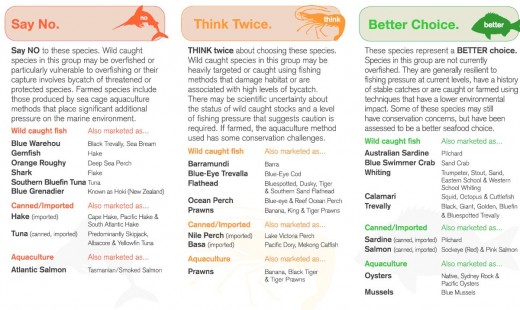
Processed and Packaged Foods
Modern society’s predilection for fast and convenient foods has led to the reliance on processed and packaged foods. There are far too many choices, brands and varieties of the same product. The average supermarket stocks 1,800 different varieties of food. The degree of our excessiveness is highlighted through the perspective of Valerie Browning, a nurse based in Ethiopia, on her trip back to Australia to visit family:
"I hadn’t asked what sort of bread she wanted. I didn’t think I needed to as where I come from bread is simply bread. Not in Australia. Aisha (her daughter) and I were stunned at the choices on offer. There were bread with nuts on, bread with seeds on -or off; bread made out of this or that sort of flour; bread with oats in it, or pumpkin seeds on it, or honey, or .....it was bewildering.
In Addis Abada or Logia, we go to the bakery, tell them how many pieces we want and that’s it. It's the same with milk. In Australia, milk is calcium-enriched - or not; light; skim; full cream with this or that added; long-life or fresh.... it goes on and on.
I'm glad we don't have that choice. In my opinion, the west has gone overboard on choice. People say it's their right to consume. It's their right to have everything packaged and padded, see-through or not see-through, to own not one but two or three gas-guzzling motor cars which consume limited petroleum resources and contribute to the destruction of the planet. It's their right in Australia to own 15 million mobile phones, each one full of chips and plastic, so that they can make millions of unnecessary calls, and play games on them or take photographs. It's their right to chase obsessively after greater and greater wealth, more possessions, and consume more and more products while the rest of the world starves."
From the memoir Maalika- My life among the Afar nomads of Africa, Valerie Browning with John Little
Kilojoules required to process 1kg of some common foods
Flour–2,100 kj
Canned Fruit–2,500 kj
Bottled water–3,000 kj Soft drink–5,900 kj
Low kilojoule soft drink–25,000 kj
Chocolate–77,000 kj
Instant coffee–79,000 kj
The production of processed foods is an energy and resources intensive process. They are generally individually wrapped, bagged and overpackaged in plastics, which contributes to the problem of waste and pollution.
Reducing the Impact of Processed Foods – Personal Action
- Use fewer processed products, therefore more cooking at home and cooking foods from scratch.
- Choose products with less processing i.e. rolled oats as opposed to sugary cereals
- Grow your own produce and divert food waste to composting
- Encourage and support concepts such as Stephanie Alexander’s Kitchen Garden – a program that teaches children how to grow, harvest, prepare and share fresh, seasonal food.
Reducing the Impact of Packaged Foods – Personal Action
- Choose foods with less or no packaging
- Reduce plastic waste – carry reusable shopping bags and use refillable drink bottles wherever you can. Approximately 4 billion water bottles are disposed globally every year, ending up in landfill.
- Opt for reusable coffee cups, such as the KeepCup, when purchasing takeaway coffee
- Lobby all levels of government i.e. local government for recycle bins, state government to set mandatory rules for container deposits, federal government to include recycling costs in the product price
- Use brown paper bags over white paper bags. White paper bags are bleached using chlorine or other chemicals, which creates pollution.
- Use environmentally friendly food packaging i.e. cellophane (recyclable and biodegradable), greaseproof paper (recyclable and compostable), bio-cling wrap (biodegradable), 100% post-consumer recycled paper (from material that has been used at least once as a paper product and then recycled). A biodegradable product is able to be broken into carbon dioxide, water and biomass through bacteria or other biological means. A compostable product is biodegradable, but also releases valuable soil nutrients when broken down.
- Avoid using items that are not biodegradable i.e. polystyrene cups, trays; plastic film wrap, cutlery and straws
Environmentally Friendly Material
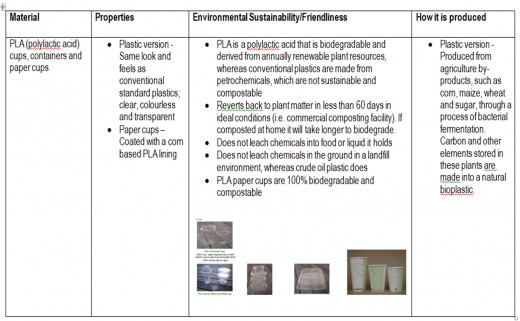
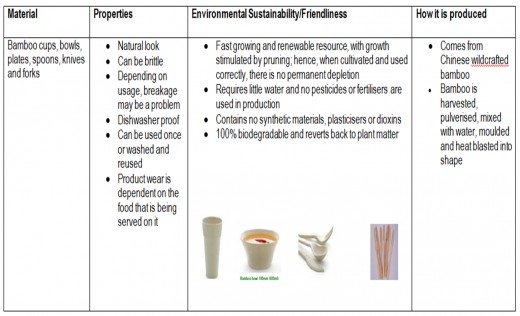
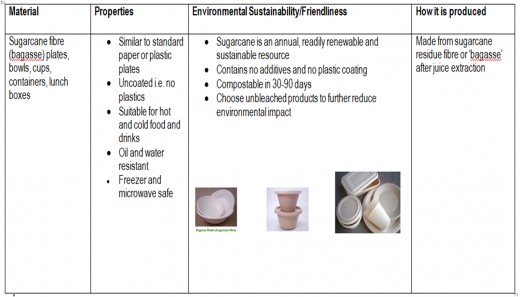
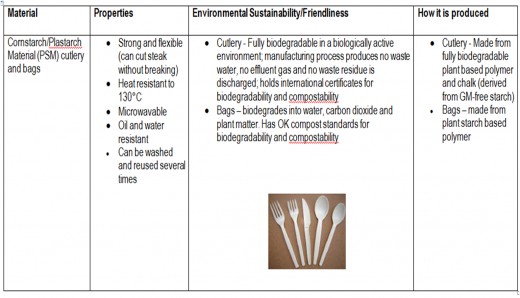
Table contents sourced from www.vsca.org.au/pdfs/VSCAEnviroFriendlier.pdf
Obesity, Overweight and Social Equity
The problem with overconsumption is that it uses energy and resources at an enormous rate to produce animal and processed foods for someone that has more than enough food, while depriving someone else of having adequate food. The prevalence of overweight and obesity and undernourishment has increased and is a reflection of unequal global food distribution. According to the World Health Organisation, obesity has doubled since 1980 and in 2008, it was estimated that globally 1.5 billion adults are overweight or obese and nearly 43 million children under 5 years of age are overweight. The International Food Policy Research Institute and the Food and Agriculture Organization of the United Nations estimated that the number of undernourished people in the world increased from 848 million to 963 million between 2003-05 and 2008.
The world can only produce so much food; hence, to ensure a more even distribution, the extra energy used to produce food for someone with more than enough can be redirected to those who are starving. This includes improving access to land and productive resources, investing in public health and education and creating a more just and sustainable multilateral trading system.
Go Organic
Organic farming is more environmentally friendly and sustainable than conventional farming methods as crop and livestock are grown and reared without artificial fertilisers, pesticides and chemical feeds and growth hormones and antibiotics. Organic produce is not necessarily chemical free, but pesticide residues are considerably less than foods produced with synthetic chemicals.
The use of chemical nitrogen fertilisers and pesticides in industrialised farming contributes to nitrous oxide emissions (significant greenhouse gas that is over 300 times more potent the carbon dioxide over a 100 year period) and inhibits the ability of soil to store carbon. However, organic farming relies more on naturally occurring nutrients in manure, compost and leguminous plants, resulting in a lower nitrous oxide output compared to conventional farming. Studies have found that organic farms produced 40-60% less emissions per hectare than conventionally farmed soils.
PERSONAL ACTION
- Buy organic products (usually clearly labelled)
- Grow your own vegetables and divert food waste to composting
Best organic buys
Purchase these organic varieties as they require high levels of pesticides when grown conventionally
Apples, cherries, nectarines, capsicum/peppers, grapes, peaches, carrots, kale, pears, celery, lettuces, strawberries
Best conventional buys
Opt for conventionally grown vegetables that use fewer pesticides due to their thicker skin or peel
Asparagus, avocado, broccoli, cabbage, sweet corn, eggplants, kiwi, mango, onion, papaya, pineapple, sweat peas, sweet potatoes, tomatoes, watermelon
**Further information at Sustainable Living Guide and the Rodale Institute
Reducing transport emissions by sourcing local and seasonal produce
Seasonal foods are fresher, more nutritious and generally taste better. Produce bought out of season are most probably imported and have travelled hundreds or thousands of kilometres during transportation, thereby contributing to carbon emissions. In this respect, purchasing a locally produced conventional food is better than an organic food produced overseas.
Source food from local food systems:
- Shop at local farmers markets
- Grow your own fruits and vegetables
- Develop and encourage Community Supported Agriculture (CSA). CSA is a relatively new socioeconomic model of food production, sales and distribution. This enables consumers to purchase local and seasonal produce directly from farmers. It involves farmers offering a certain number of produce over a certain time period to the public i.e. a box, bag or basket of seasonal vegetables (other farm products may be included) each week throughout the farming season. Interested consumers then purchase the produce under the agreed arrangement in order to get a fresh and seasonal supply of produce.
- Develop and encourage Farm to School Programs. This is a US based program designed to connect schools (K-12) to local farms with the aim of serving healthy meals in school cafeterias. Another similar concept is the Stephanie Alexander’s Kitchen Garden – an Australian program that teaches children how to grow, harvest, prepare and share fresh, seasonal food.
- Develop a garden sharing arrangement - a local food and urban farming scheme. This involves an arrangement between two parties where one supplies the land and the other supplies the labour, and all harvest is shared. In some instances, neighbours share garden spaces, labour and the harvest.
Phosphate – A Depleting Resource & Issues with Global Food Security
Phosphorus is necessary for the growth of all living organisms. In humans it comes from our food sources. Agriculture is dependent on phosphorus as it is a key component of fertiliser, hence all farmers need phosphorus. Fertiliser helps feed billions of people by boosting crop yields. Phosphorus is derived from phosphate rock, which is mined. Currently, 90% of mined phosphate rock is used in food production, highlighting the pivotal role this nutrient plays in the food system.
The current global reserves of phosphate rock will be depleted in 50-100 years based on current levels of extraction. Only 5 countries in the world control around 90% of the world’s remaining reserves, including China, United States and Morocco and Western Sahara. This is a major threat to food security as the world’s phosphorus supply is highly sensitive to the bureaucratic, social, environmental, economic and political risks of those countries. Furthermore, the increasing demand for biofuels (derived from crops), driven by depleting global oil reserves, has resulted in the food and energy sectors competing for phosphate rock – an additional threat to global food security.
Phosphate rock is a non-renewable resource and it can not be manufactured. It is one of there world’s most traded commodities. There are currently no alternatives on the market that will replace the demand for phosphate rock. Given the pivotal role of phosphorus in food production and its scarcity, it is surprising that it is not a priority agenda within key discussions on global food security. There is currently no international and co-ordinated global governance of phosphorus and no international policies, regimes, guidelines and organisations responsible for securing long-term availability of phosphorus for food production.
ENVIRONMENTAL CONCERNS
Mining, processing and transporting phosphorus are an energy intensive process.

Processing phosphate rock produces significant waste – 1 tonne of phosphate rock produces 5 tonnes of radioactive phosphogypsum waste. Its radioactivity prohibits further use, so it is stockpiled. A major concern is the leaching of stockpiled material into waterways.
Phosphate rock is accepted as a natural fertiliser in organic agriculture
Only 30% of phosphate in fertilisers is actually used by the crop. The remaining phosphate remains in the soil or as waste in waterways, causing pollution such as algae blooms.
POSSIBLE SOLUTIONS
Recovering phosphate from human excrement
Unlike oil, phosphate can be recovered once used e.g. reuse crop residues, use food waste as compost, manure and human urine as it is sterile and can be applied as a liquid fertiliser. A lot of phosphorus is lost in all key stages of production, including human excretion (faeces and urine). Each year humans generate 3 million tonnes of phosphorus waste which end up in waterways. The optimum chance to recover human excrement is when it is in the toilet or sewer pipes, as this is when it is in its most concentrated form. Once it has dissipated into water, it is diluted and becomes unfeasible to recover. The added advantage of using excrement is that it is a renewable resource.
In Sweden two municipals have mandated a law that all new toilets should be urine diverting. A urine diverting toilet has an extra tiny hole in the toilet bowl to enable the capture of urine, which is usually stored in a storage tank for further use or processing. Sweden has a target that 60% of phosphorus from sewerage should be redirected to land.
Other Solutions
Decrease the demand for phosphorus, so less phosphorus demanding diets such as meat
Unlocking phosphorus in soils; focusing on soil microbiology, pH and moisture content can help unlock the phosphorus.
Go to the Global Phosphorus Research Initiative or watch the University of Technology, Sydney's seminar, Eating the Earth - How We should Eat to Ensure a Sustainable Future for more information.
What’s Your Personal Ecological Footprint?
To find your biggest areas of resource consumption, and to learn what you can do to reduce your environmental impact, take the quiz at Global Footprint Network.
http://www.footprintnetwork.org/en/index.php/GFN/page/personal_footprint/
Most foods we eat are unsustainable and not desirable for health. It is the heightened awareness and understanding about the food system’s impact on broader issues – health, environment, human rights, social equity, animal rights – that drives change and action in our food and diet. By taking an interest in where food comes from and where it all goes to, we are a step closer towards global food security and sustainability.

